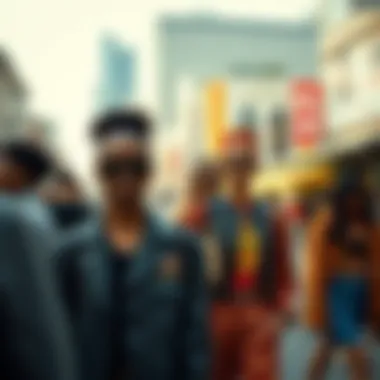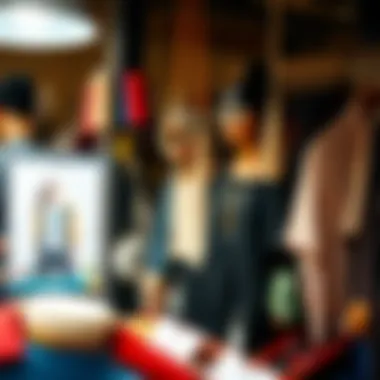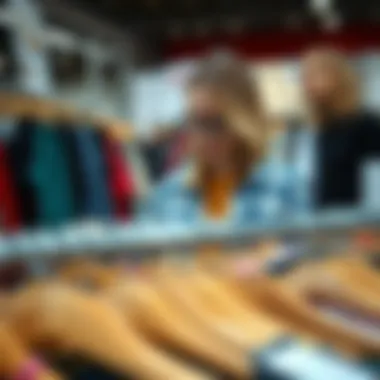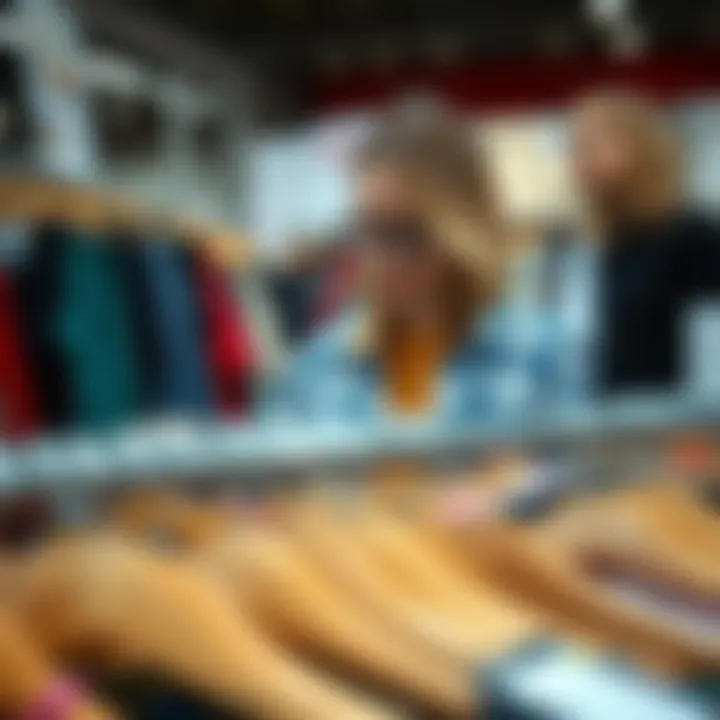City Trends in Fashion: Understanding Local Influences


Intro
As the world spins on its axis, cities pulse with trends that reflect their unique identities. Fashion isn’t just what you see on runways in high-end magazines; it’s alive in the streets, markets, and cafes of every urban landscape. In this article, we dive deep into understanding these city-driven trends, exploring how local influences shape what we wear and how we express ourselves. For stylists, designers, and retail professionals, recognizing these dynamics isn’t just advantageous—it’s essential.
This exploration isn’t merely about the shiny fabrics and colors pertinent to certain seasons; it seeks to uncover the narratives behind what becomes fashionable. It raises questions like: How does a city’s culture inform personal style? What small nuances in daily life can inspire a fresh look? With these considerations, you can start to curate your wardrobe based on your geographic surroundings, drawing from the rich tapestry woven by local fashion.
Current Trends in Fashion
In the modern fashion scene, each season seems to unveil its hallmark styles, influenced by a medley of local culture, social movements, and global events. It's about breathing in the essence of a city’s vibe and letting it reflect in personal attire.
Key Styles of the Season
This season, a few key styles promise to grab attention. Here are some that have emerged, each echoing a particular culture or sentiment:
- Gender-fluid silhouettes: Merging traditional gender norms, creating a tapestry of shared styles.
- Sustainable choices: Wearing pieces that resonate with eco-conscious living. Brands like Patagonia and Everlane have paved the way here.
- Vintage revivals: This trend finds its footing in thrift shops, where unique finds tell stories of yesteryears.
- Bold prints and patterns: From retro florals to graphic designs, prints are making a statement.
- Streetwear influences: With a nod to urban culture, oversized garments continue to dominate, merging comfort with style.
Influential Designers and Their Impact
Fashion does not thrive in a vacuum, and many designers have stomped onto the scene with fresh perspectives:
- Virgil Abloh brought streetwear into the high-fashion arena with Off-White, challenging traditional boundaries.
- Alexander McQueen has always used fashion to make societal commentary, integrating historical themes in contemporary designs.
"Fashion is about dreaming and making other people dream." - Donatella Versace
Practical Fashion Advice
Styles may evolve, yet the essentials of wardrobe building remain tried and true. Armed with a keen understanding of local trends, you can elevate your personal style.
Guidelines for Choosing the Right Fabrics
Choosing the appropriate fabric is crucial for both visual appeal and comfort. Consider these essentials:
- Natural fibers: Cotton, linen, and wool breathe well and have a luxurious feel.
- Sustainable materials: Explore Tencel or recycled polyesters for a greener footprint.
- Durability: Invest in well-constructed items. A shirt made from high-thread-count cotton might last longer than a cheaper polyester alternative.
Tips for Building a Versatile Wardrobe
A versatile wardrobe offers numerous combinations that enable personalization based on locality:
- Staple pieces: Invest in a classic black blazer and slim jeans—these can be dressed up or down.
- Layering basics: T-shirts and turtlenecks in neutral colors work under blazers or cardigans.
- Accessorizing: Scarves, belts, and hats can shift a look immensely, reflecting local flair without an entire outfit overhaul.
Fashion isn’t just about wearing items; it’s about telling your story through them. By understanding the local influences that shape fashion trends, designers and retailers can create offerings that resonate with the community, making every outfit a reflection of personal identity and a celebration of local culture.
For those wanting deeper insights into local trends, resources like Wikipedia and Britannica can offer historical context, while social platforms like Reddit house dynamic discussions among fashion enthusiasts.
Understanding City Trends
City trends encompass a fascinating interplay of cultural, social, and economic factors that reflect the identity of urban life. In an age driven by fast fashion and ever-changing styles, understanding these trends becomes essential not just for observers, but also for those in creative fields such as fashion design, styling, and retail. This article aims to unpack the dynamics behind city trends, emphasizing how local variations shape the larger fashion landscape.
Key Benefits of Understanding City Trends:
- Cultural Relevance: Recognizing what is trending in a specific area allows designers and retailers to be in tune with their audiences, creating collections that resonate with local sentiments.
- Consumer Insight: As each city possesses its own unique demographic, knowing city trends helps in tailoring marketing strategies and improving customer engagement.
- Community Connection: Emphasizing local trends fosters a sense of belonging, giving fashion a more personal touch.
- Sustainable Practices: By focusing on local styles, brands can minimize their carbon footprint, promoting sustainability in fashion.
In this context, let’s delve into the various aspects of city trends that contribute to this dynamic environment.
Defining City Trends
When we talk about city trends, we refer to prevailing styles, patterns, or fashions that emerge within specific urban areas. These trends differ from the global fashion movements, as they are influenced by the unique characteristics, history, and culture of each locale. A trend in New York might not resonate with a city like Mumbai, as the cultural reference points and consumer behaviors vary widely.
Examples of city trends include street style in Berlin, known for its artsy edge, or the sophisticated yet relaxed vibe of Milanese fashion. These distinctions highlight how a city’s lifestyle directly impacts its fashion narrative. A defining aspect of city trends lies in their ability to shift and evolve, often mirroring sociopolitical changes or economic conditions.
The Role of Geography in Fashion


Geography plays an integral role in determining what trends flourish in a city. The climate, landscape, and even architectural styles influence the type of materials used and the silhouettes adopted. For instance, lighter fabrics and breezy silhouettes become commonplace in coastal cities like Los Angeles, while heavier fabrics make more sense in regions like Toronto, where winter reigns supreme.
In addition, geographic regions hold symbolic meanings within fashion. Certain colors or styles become synonymous with their location—think of the earthy tones worn in rural settings versus the bold, vibrant colors prevalent in urban centers. This geographical differentiation serves not just as a fashion influence, but also as a storytelling device that encapsulates the mood of a place.
How Trends Evolve Locally
Trends in fashion are not static; they evolve through a complex exchange of local influences and wider cultural touchpoints. They are shaped by micro-communities within cities—neighborhoods, schools, and social groups each have their own distinctive style signatures. Events such as music festivals or art walks often ignite trends, leading to a local fashion renaissance.
For instance, the popularity of practical yet stylish attire—like utility jackets or combat boots—often takes hold in creative districts as artists and influencers champion these pieces. Furthermore, as cities grow and diversify, the fusion of various influences results in the emergence of new trends that reflect collective identities as opposed to individual styles.
In essence, understanding city trends is pivotal for fashion professionals who aim to create relevant and resonant collections that embody the spirit of their local communities. These nuances, pulled from the interplay of geography, culture, and social dynamics, illuminate the vibrant tapestry that is urban fashion.
Local Influences on Fashion
Understanding the local influences on fashion is akin to peeking behind the curtain of a city’s cultural fabric. Each city tells a story through its unique style narratives, shaped by the multifaceted interactions between its people, history, and environment. This section explores how these local nuances define fashion trends, offering insights that are particularly valuable for fashion designers, stylists, and retail workers.
Cultural Significance
Cultural significance plays a pivotal role in fashion, shaping not only what people wear but also how they express their identities. Take New Orleans as an example; the vibrant culture of Mardi Gras greatly impacts local fashion choices. Here, colors and bold patterns come together, telling stories of tradition and community. Similarly, in cities like Kyoto, traditional garments such as kimonos are revitalized with modern fabric to attract younger generations, showcasing a blend of the past and present.
The impact of culture goes beyond aesthetics. It imbues garments with meaning—items are not merely articles of clothing but symbols of heritage and belonging. Communities tend to rally around local designers who reflect these cultural values, helping foster a sense of identification through style. This illustrates the symbiotic relationship between culture and fashion, where one continually influences the other.
Historical Context
History is another integral thread in the tapestry of local fashion. Understanding how historical events shape styles can give astonishing insights into contemporary preferences. Consider how the punk movement in the 1970s in London birthed a distinctive style defined by rebellious fashion choices. This not only influenced designers globally but also left a lasting legacy, allowing punk aesthetics to evolve into today’s street style.
Cities often carry the weight of their historical contexts, and this is reflected in their fashion. Urban areas that have undergone significant transformations often find their fashion embodying these changes. For example, cities that experienced millennial renaissance often see a revival of vintage styles, as a generational nostalgia influences current trends.
Community Engagement
Community engagement is crucial in understanding how local fashion trends are born and nurtured. Local events, pop-up shops, and fashion markets serve as breeding grounds for creativity and inspiration. Designers can tap into community feedback, allowing them to create pieces that resonate with their audience.
A perfect illustration comes from the rise of streetwear culture. Many streetwear lines begin within neighborhoods; passionate individuals often gather to share ideas, experiment with aesthetics, and collaborate. This grassroots approach to fashion fosters a sense of collective ownership in local trends, encouraging a dynamic environment where styles can flourish organically--without relying heavily on mainstream validation.
"Fashion is what you buy; style is what you do with it. In every city, this philosophy is shaped by its people and their stories."
By grasping the extent of cultural significance, historical contexts, and community engagement, fashion professionals position themselves to create styles that resonate deeply within urban landscapes. Such understanding forms the foundation for building not just clothing brands but authentic narratives that truly connect with their audience.
Discovering Trends Near You
The essence of discovering trends tailored to your locale lies in understanding the intricacies of individual city influences as they relate to fashion. This segment explores the various ways through which one can stay in touch with local styles, allowing fashion enthusiasts and professionals alike to customize their wardrobes in a way that resonates with their environment. By connecting with the cultural, social, and historical context of a place, individuals can bring their unique flair into mainstream fashion. This kind of localized trend awareness not only enhances personal style but also fosters community identity.
Utilizing Social Media and Local Platforms
In today’s digitally driven world, social media serves as an invaluable tool for spotting trends that bubble up in local scenes. Platforms like Instagram, Pinterest, and TikTok are teeming with creative minds sharing their fashion statements and inspirations. Following local influencers or fashion accounts can provide a glimpse of what styles are gaining traction within your community.
As an example, consider joining local Facebook groups where fashion enthusiasts congregate. These groups often share events, discoveries, and even second-hand sales that reflect the unique flavor of your area's style scene.
"Social media is not just a showcase, but a map guiding you to the heart of local trends."
Events and Fashion Weeks
Attending local fashion events and design weeks can be a game changer in recognizing emerging trends. These gatherings showcase the creativity and craftsmanship of local designers while also setting the tone for upcoming seasons. Each city often has its own flavor during these events; for instance, New York’s bustling environment allows for a fast-paced style evolution, while a quaint town’s fashion week might spotlight a slower, more artisanal approach.
Moreover, exploring runway shows, exhibitions, and even pop-up events can enable you to connect with designers directly and understand their inspirations and design processes. Don't miss the chance to chat with local fashionistas at these events—insightful conversations often lead to eye-opening revelations about trends that may not yet be widely recognized.
Pop-up Shops and Local Designers
Pop-up shops are a treasure trove for discovering local fashion trends. These temporary retail spaces typically feature unique collections, allowing local designers to present their work without the burdens of long-term retail overhead. The experience of shopping at a pop-up shop provides an intimate atmosphere where you can interact directly with designers and understand their vision.
Buying from local designers not only helps support your community but also ensures that your wardrobe reflects the craftsmanship and innovation stemming from your surroundings. It allows consumers an opportunity to nab one-of-a-kind pieces that tell a story tied to the region’s cultural and artistic fabric.
In summary, the avenues to discover local trends go beyond mere observation; they require active engagement and an openness to experience. Whether through social media, events, or shopping local, each interaction builds a bridge to the ever-evolving tapestry of fashion that defines your city.


Creating a Personal Style Statement
Creating a personal style statement is more than just selecting clothes; it’s about articulating who you are and reflecting your unique perspective on the world. This section will delve into the significance of crafting a personal style, examining how it enables individuals to convey their identity while remaining attuned to local trends and global influences.
A well-defined personal style can serve as a powerful form of self-expression. It allows one to communicate their values, beliefs, and passions without saying a single word. In a society saturated with fleeting styles and ever-changing trends, establishing a signature look can offer a sense of consistency and authenticity. When you dress in a way that resonates with your inner self, it not only enhances your confidence but also enriches your interactions with others.
Identifying Your Influences
To create a personal style statement, first, one must identify the various influences that shape it. These influences can stem from numerous sources:
- Cultural Background: Your heritage often infuses your style choices, reflecting the unique customs and aesthetics of your background. Consider how traditional clothing shapes your fashion sense.
- Local Trends: Being mindful of the styles popular in your city can help you curate a wardrobe that feels relevant yet personal. There is often a blend of global fashion with local motifs that deserves examination.
- Inspirational Icons: Influencers, celebrities, and even friends can offer a reference point. Notice whom you admire for their style and what aspects resonate with you—this can guide your choices.
By recognizing these influences, you can start to draft a style narrative that feels distinctly yours.
Combining Local Trends with Personal Taste
The beauty of fashion lies in its adaptability. Combining local trends with your personal taste involves finding that sweet spot between what's in vogue and what feels right for you. Here are a few approaches to achieving this fusion:
- Experiment: Don’t hesitate to try on various styles that reflect local trends. You may find that a certain texture or pattern speaks to you more than others.
- Incorporate Unique Pieces: Local designers often draw inspiration from their environment. Incorporating a standout piece from a local boutique can be a fantastic way to enhance a global style with community flair.
- Accessorize Wisely: Accessories can be a low-commitment way to embrace trends. Whether it's a handcrafted bag from a neighborhood artisan or locally made jewelry, these details can connect your outfit visually and culturally.
Ultimately, the goal is to feel comfortable and authentic. The more you align with your true self, the more you’ll resonate with those around you.
Sustainability in Local Fashion
In recent years, sustainability has become a crucial aspect of fashion. For those aiming to create a personal style statement, considering the ecological impact of your wardrobe is essential. Here are some insights into incorporating sustainability into your fashion journey:
- Support Local Brands: Shopping locally not only diminishes the carbon footprint linked to long-distance shipping but also bolsters community businesses. Many local designers prioritize sustainable practices in their production.
- Choose Quality Over Quantity: Invest in well-made pieces rather than fast fashion. These items tend to have a longer lifespan, thereby reducing waste.
- Thrift Shopping: Venture into thrift stores or vintage shops. You’ll uncover unique finds while also minimizing your environmental footprint.
"Fashion is art, and you are the canvas. Choose sustainable hues that tell your story without harming the world."
By integrating sustainability into your personal style, you not only elevate your fashion sense but also contribute to the broader movement towards responsible consumption.
In wrapping up this section, crafting a personal style statement involves introspection and creativity. By identifying influences, merging local trends with your taste, and adopting sustainable practices, you create not just a wardrobe but also a narrative that speaks to who you are. Stay willing to evolve as your surroundings change, and remember, fashion can be an avenue for personal storytelling that connects you with your community.
Shopping Strategies for City Trends
In the ever-evolving world of fashion, understanding how to shop effectively is paramount, especially in an urban context. City trends don’t just spring from nowhere; they marinate in a unique blend of cultural influences, accessibility to resources, and community engagement. Knowing how to navigate these elements fosters a more satisfying shopping experience while allowing individuals to express their personal style authentically.
Adopting solid shopping strategies tailored to city trends can enhance your wardrobe, ensuring it resonates with both local flair and personal identity. When diving into this world, it's vital to consider how local boutiques, thrift stores, and seasonal shifts play significant roles in shaping available fashion choices.
Finding Local Boutiques
Local boutiques often serve as the beating heart of city fashion. They offer unique pieces that reflect the culture and aesthetics of the area, making them far more desirable than mass-produced items. By visiting these stores, shoppers can not only discover distinct styles but also support small businesses. Often, the personal touch provided by boutique owners can lead to insightful recommendations tailored to your style preferences.
Considerations When Seeking Boutiques:
- Location: Exploring different neighborhoods can yield unexpected finds. A hidden gem might just be around the corner, waiting to be uncovered.
- Community Engagement: Many boutiques hold events or collaborate with local artists and designers. These activities often introduce fresh trends that resonate with the surrounding community.
- Sustainability Focus: Local boutiques often prioritize sustainable practices, a growing demand among consumers. This contributes to eco-friendly shopping choices.
Navigating Thrift Culture
Thrifting has gained immense traction in recent years, not only as a means for budget-savvy shoppers to find unique pieces, but also as a way to contribute to sustainable fashion. Each thrift store has its own character, often packed with nostalgia and untapped potential.
Why Thrift?
- Originality: You’re less likely to bump into someone wearing the same outfit when you shop second-hand.
- Affordability: Thrift stores typically charge far less than retail, allowing for more adventurous choices without breaking the bank.
- Environmental Impact: Purchasing second-hand reduces waste and minimizes the demand for fast fashion.
Tips for Successful Thrifting:
- Go often: Inventory at thrift stores changes frequently. Popping in every few weeks can help you snag unique items.
- Be patient: Finding that perfect piece can take time. Sift through items with an open mind.
- Check back regularly: Many thrift shops refresh their stock on specific days, making it beneficial to have a routine.
Understanding Seasonal Changes
Fashion, much like the seasons, is cyclical. The trends that dominate each season heavily influence shopping behaviors and can dictate what styles emerge prominently. Understanding these seasonal changes allows consumers to be proactive rather than reactive in their style choices.


Key Insights on Seasonal Shopping:
- Fall Collections: As temperatures drop, layers and deeper color palettes take center stage. Investing in essentials like jackets and boots can provide versatility and longevity.
- Spring Refresh: Light fabrics, floral patterns, and vibrant colors re-emerge during warmer months. It’s the perfect opportunity to refresh your wardrobe with a mix of bold and soft hues.
- End-of-Season Sales: This is often when you can snag great deals on seasonal items. Planning purchases around these sales allows buyers to strategize their styles effectively without overspending.
By honing these shopping strategies, individuals can not only navigate city trends efficiently but can also cultivate personal styles that reflect their identity. Each shopping experience becomes an opportunity to engage with the vibrant tapestry of urban fashion, creating a wardrobe that is as unique as the city itself.
Case Studies of City Trends
Examining case studies of city trends offers a valuable look into the specific influences and dynamics that shape local fashion landscapes. These specific studies serve a dual purpose: they illustrate how cultural, social, and economic factors weave into the fabric of urban style, and they provide concrete examples for analysis. By analyzing notable cities, fashion designers and retail workers can derive insights into emerging trends, consumer preferences, and even challenges that come with localized fashion movements. This exploration can stimulate fresh ideas and innovative approaches in one’s own local contexts.
Urban Fashion in Major Cities
New York
New York is often considered the heart of fashion, where trends are born and diffused globally. The chaotic rhythm of the city contributes greatly to its unique fashion scene. Key characteristics such as diversity, artistic expression, and the influence of both high fashion and streetwear converge in this urban jungle. The city is home to renowned events like New York Fashion Week, which sets the tone for styles worldwide.
Unique feature: One of New York’s standout traits is its ability to blend different cultural influences seamlessly. From the polished streets of Manhattan to the vibrant neighborhoods of Brooklyn, there's something for everyone. The advantage here is multilayered; designers and retailers can draw inspiration from a mosaic of styles that appeal to various demographics. However, the sheer scale can sometimes complicate how trends take root locally, with fast fashion overpowering unique local artisans.
Tokyo
Tokyo offers a fascinating counterpoint to Western fashion trends, showcasing a juxtaposition of tradition and futuristic styles. A city renowned for its eclectic fashion subcultures, Tokyo’s streets are filled with visually striking outfits that can range from traditional kimonos to avant-garde designs. The city’s vibrant youth culture plays a critical role in driving trends, leading to a constant evolution of styles.
Key characteristic: Tokyo’s fashion scene is marked by its emphasis on individuality. The Japanese have a cultural penchant for self-expression through clothing, which translates to bold, experimental hairstyles and artistic layering. This opens doors for emerging designers to either adhere to or break away from norms. Nonetheless, the rapid pace of change can put pressure on local designers who struggle to keep up with ever-shifting tastes.
Paris
As the fashion capital of the world, Paris has long been synonymous with luxury and haute couture. The Parisian style embodies effortless chic — a balanced concoction of sophistication intertwined with a vibe of casual elegance. The city’s history of high fashion has cemented its reputation, with iconic houses like Chanel, Dior, and Louis Vuitton rooted deeply in its culture.
Unique feature: The charm of Paris lies in its romantic aesthetic and historical cultural influences woven throughout. The city encourages a slower fashion tempo, valued for timeless pieces rather than fleeting trends. For individuals and brands, this presents an opportunity to develop collections that draw from historical contexts while remaining contemporary. However, this can also create an air of exclusivity that might alienate those outside the upper echelons of fashion.
Emerging Markets
Influence of Smaller Cities
Smaller cities are often overlooked in discussions about fashion trends, yet they can provide a rich source of originality and creativity. These communities frequently foster close-knit relationships that allow for innovation in local styles shaped by distinct cultural backgrounds and needs. Their unique characteristics often create trends that are more relatable and accessible than those seen in larger metropolitan areas.
One advantage is that smaller cities can cater directly to their local populations, granting them flexibility to adapt quicker to what resonates with their community. However, limited resources can hinder their ability to scale or gain substantial visibility in a global market.
Rural Trends
Rural areas may not immediately spring to mind when considering city trends, yet they contribute to an interesting dialogue within the fashion landscape. Trends from these environments offer a rustic charm often shunned by urban fashionistas but embraced by many for their authenticity. Traditional garments, handmade goods, and sustainable practices often define rural trends, offering eco-conscious consumers an alternative.
Rural fashion's distinctiveness lies in its respect for craftsmanship and quality materials — mountains of unique fabrics may not suit high-speed fashion cycles but can still capture attention for their storytelling and heritage aspects. Yet, the challenge remains in marrying this allure with broader market demands, as rural designs often struggle to find their place within fast-paced city environments.
The Future of City Trends
The dynamics of city trends are shifting rapidly, shaped by technology, cultural movements, and changing consumer behavior. This section explores these evolving aspects and how they might influence the future of fashion in urban environments. Understanding these trends not only helps designers and retailers stay relevant but also empowers consumers to make informed fashion choices that resonate with their personal styles.
Technology's Role in Fashion Discovery
Technology is reshaping how fashion trends are discovered and disseminated. Social media platforms, particularly Instagram and TikTok, have become vital tools for both creators and consumers. Here are some aspects of technology's impact on fashion:
- Algorithmic Recommendations: Personalized feeds tailor content based on user preferences, showcasing styles aligned with individual tastes. This means that a fashion-forward outfit from a local designer can gain visibility in ways that previously seemed impossible.
- Virtual Shopping: Innovations such as augmented reality allow users to try on clothes virtually before making a purchase. This technology is giving rise to a new shopping experience, making it convenient and interactive.
- Data Analytics: Fashion brands harness big data to track consumer preferences and trends, enabling them to adapt their collections more responsively. By analyzing purchasing behaviors and engagement metrics, businesses can forecast trends with greater accuracy.
"The future is increasingly about personalization within fashion, driven largely by technology."
Consumer Preferences Shaping Trends
As millennials and Gen Z navigate their purchasing decisions, their preferences significantly influence fashion trends. This generation demands authenticity, sustainability, and inclusivity in the brands they support. A few pivotal aspects include:
- Demand for Sustainability: There’s an undeniable shift toward eco-friendly fashion. Brands that prioritize sustainable practices are being embraced, while those that disregard them often find themselves sidelined.
- Cultural Awareness: As consumers become more aware of cultural appropriation and representation, they seek brands that celebrate authenticity. Designers play a critical role in telling meaningful stories through their creations, ensuring respect for diverse cultures.
- Inclusive Marketing: Fashion brands are re-evaluating their marketing strategies to reflect the diversity of their target audiences. This shift has encouraged inclusive campaigns that resonate deeply with potential buyers.
Anticipating Future Trends
Looking ahead, the ability to anticipate trends will be pivotal in staying ahead in the industry. Understanding shifts in social behavior, technology use, and economic conditions can provide insights into the next big things in fashion. Key points to consider include:
- Social Movements: Participation in social and political movements will likely shape trends as consumers align their purchases with their values. Fashion won't just be about clothing anymore; it'll be about a statement.
- The Role of Locality: As shopping practices shift, there's a renewed interest in hyper-local brands that offer unique styles reflecting community identity. Smaller cities and rural areas could emerge as significant influencers in broader fashion trends.
- Digital Collectibles: The rise of NFTs within fashion might redefine ownership and authenticity. Brands exploring themes of digital versus physical products could resonate well with tech-savvy consumers.
By keeping abreast of these technological innovations, consumer shifts, and potential future trends, industry professionals and fashion enthusiasts will be better equipped to adapt and thrive in an ever-changing landscape.















